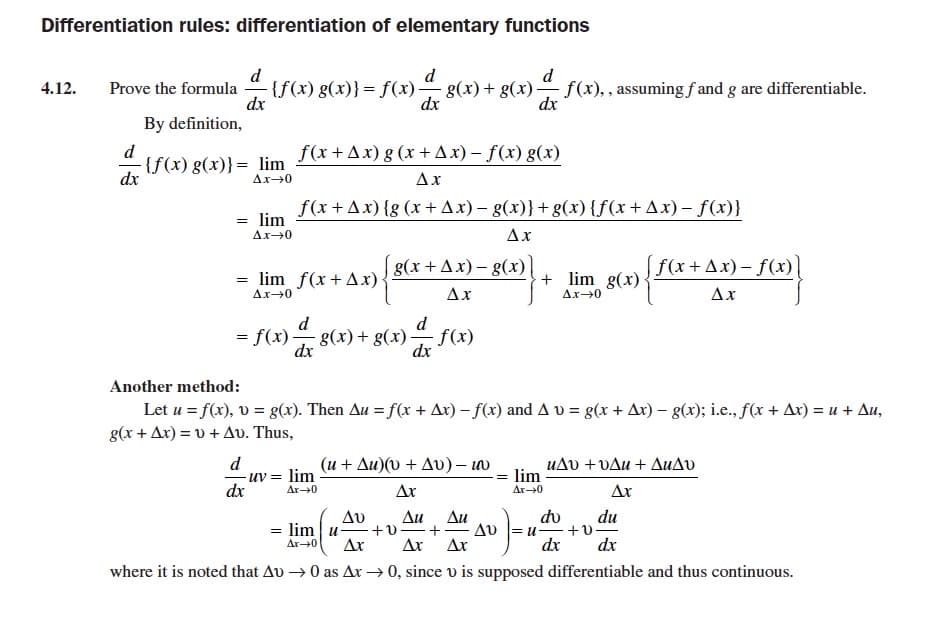Differentiation rules: differentiation of elementary functions d d d -{f(x) g(x)}= f(x) 8(x) + g(x). dx f(x),, assuming f and g are differentiable. dx 4.12. Prove the formula dx By definition, d f(x +Ax) g (x +Ax) – f(x) g(x) {f(x) g(x)}= lim dx Ax-0 Ax f(x+Ax) {g (x +Ax) – g(x)}+g(x) {f(x+Ax) – f(x)} lim Ax-0 Ax g(x +Ax) - g(x) f(x+ Ax) - f(x) = lim f(x +Ax) + lim g(x) Ax→0 Ax Ax→0 Ax d d = f(x) 8(x)+ g(x) f(x) dx dx Another method: Let u = f(x), v = g(x). Then Au = f(x + Ax) – f(x) and A v = g(x + Ax) – g(x); i.e., f(x + Ar) = u + Au, g(x + Ar) = v + Av. Thus, d uv = lim (и + Ди)(0 + дu) — w uAv +vAu + AuAv lim dx Ar→0 Ar Ar0 Ax dv du Δυ = lim u Ar Au Au Av = u- + Ax Ar-0 Ar dx dx where it is noted that Au →0 as Ar → 0, since v is supposed differentiable and thus continuous.
Differentiation rules: differentiation of elementary functions d d d -{f(x) g(x)}= f(x) 8(x) + g(x). dx f(x),, assuming f and g are differentiable. dx 4.12. Prove the formula dx By definition, d f(x +Ax) g (x +Ax) – f(x) g(x) {f(x) g(x)}= lim dx Ax-0 Ax f(x+Ax) {g (x +Ax) – g(x)}+g(x) {f(x+Ax) – f(x)} lim Ax-0 Ax g(x +Ax) - g(x) f(x+ Ax) - f(x) = lim f(x +Ax) + lim g(x) Ax→0 Ax Ax→0 Ax d d = f(x) 8(x)+ g(x) f(x) dx dx Another method: Let u = f(x), v = g(x). Then Au = f(x + Ax) – f(x) and A v = g(x + Ax) – g(x); i.e., f(x + Ar) = u + Au, g(x + Ar) = v + Av. Thus, d uv = lim (и + Ди)(0 + дu) — w uAv +vAu + AuAv lim dx Ar→0 Ar Ar0 Ax dv du Δυ = lim u Ar Au Au Av = u- + Ax Ar-0 Ar dx dx where it is noted that Au →0 as Ar → 0, since v is supposed differentiable and thus continuous.
Functions and Change: A Modeling Approach to College Algebra (MindTap Course List)
6th Edition
ISBN:9781337111348
Author:Bruce Crauder, Benny Evans, Alan Noell
Publisher:Bruce Crauder, Benny Evans, Alan Noell
Chapter5: A Survey Of Other Common Functions
Section5.4: Combining And Decomposing Functions
Problem 14E: Decay of Litter Litter such as leaves falls to the forest floor, where the action of insects and...
Related questions
Concept explainers
Equations and Inequations
Equations and inequalities describe the relationship between two mathematical expressions.
Linear Functions
A linear function can just be a constant, or it can be the constant multiplied with the variable like x or y. If the variables are of the form, x2, x1/2 or y2 it is not linear. The exponent over the variables should always be 1.
Question
4.12) my professor says I have to explain the steps in the solved problems in the picture. Not just copy eveything down from the text.

Transcribed Image Text:Differentiation rules: differentiation of elementary functions
d
Prove the formula
dx
By definition,
d
d
{f(x) g(x)}=
)}= f(x)g(x)+ g(x) f(x),, assuming fand g are differentiable.
4.12.
dx
dx
d
f(x +Ax) g (x +Ax) – f(x) g(x)
{f(x) g(x)}= lim
dx
Ax-0
Ax
f(x+Ax) {g (x +Ax) – g(x)}+g(x) {f(x+Ax) – f(x)}
= lim
Ax-0
Ax
g(x +Ax) - g(x)
f(x+ Ax) – f(x)
= lim f(x+Ax)
+ lim g(x)
Ax→0
Ax
Ax→0
Ax
d
d
= f(x)8(x)+ g(x)
f(x)
dx
dx
Another method:
Letu =f() , υ = g). Then Δ= f(x + Δι)-f) and Δυ- ( + Δ)-g(); ic., fr + Δε) =u+ Δι,
g( + Δ)=0 + Δυ. Thus ,
d
uv = lim
(μ+ Δυ) ( + Δυ)-ω
uAv +vAu + AuAv
lim
dx
Ar-0
Ar
Ar-0
Ax
do
du
+v
dx
Δυ
Au
+v=+
Ar
Δι
Av = u-
Ar
= lim u
Ar0
Ar
dx
where it is noted that Au → 0 as Ar → 0, since v is supposed differentiable and thus continuous.
Expert Solution
This question has been solved!
Explore an expertly crafted, step-by-step solution for a thorough understanding of key concepts.
Step by step
Solved in 3 steps with 2 images

Knowledge Booster
Learn more about
Need a deep-dive on the concept behind this application? Look no further. Learn more about this topic, calculus and related others by exploring similar questions and additional content below.Recommended textbooks for you

Functions and Change: A Modeling Approach to Coll…
Algebra
ISBN:
9781337111348
Author:
Bruce Crauder, Benny Evans, Alan Noell
Publisher:
Cengage Learning

Trigonometry (MindTap Course List)
Trigonometry
ISBN:
9781337278461
Author:
Ron Larson
Publisher:
Cengage Learning

Algebra and Trigonometry (MindTap Course List)
Algebra
ISBN:
9781305071742
Author:
James Stewart, Lothar Redlin, Saleem Watson
Publisher:
Cengage Learning

Functions and Change: A Modeling Approach to Coll…
Algebra
ISBN:
9781337111348
Author:
Bruce Crauder, Benny Evans, Alan Noell
Publisher:
Cengage Learning

Trigonometry (MindTap Course List)
Trigonometry
ISBN:
9781337278461
Author:
Ron Larson
Publisher:
Cengage Learning

Algebra and Trigonometry (MindTap Course List)
Algebra
ISBN:
9781305071742
Author:
James Stewart, Lothar Redlin, Saleem Watson
Publisher:
Cengage Learning

Algebra & Trigonometry with Analytic Geometry
Algebra
ISBN:
9781133382119
Author:
Swokowski
Publisher:
Cengage

College Algebra
Algebra
ISBN:
9781305115545
Author:
James Stewart, Lothar Redlin, Saleem Watson
Publisher:
Cengage Learning